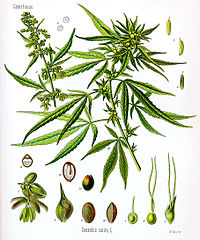
Photo from wikipedia
Oregano is a medicinal and aromatic plant of value in the pharmaceutical, food, feed additive, and cosmetic industries. Oregano breeding is still in its infancy compared with traditional crops. In… Click to show full abstract
Oregano is a medicinal and aromatic plant of value in the pharmaceutical, food, feed additive, and cosmetic industries. Oregano breeding is still in its infancy compared with traditional crops. In this study, we evaluated the phenotypes of 12 oregano genotypes and generated F1 progenies by hybridization. The density of leaf glandular secretory trichomes and the essential oil yield in the 12 oregano genotypes varied from 97–1017 per cm2 and 0.17–1.67%, respectively. These genotypes were divided into four terpene chemotypes: carvacrol-, thymol-, germacrene D/β-caryophyllene-, and linalool/β-ocimene-type. Based on phenotypic data and considering terpene chemotypes as the main breeding goal, six oregano hybrid combinations were performed. Simple sequence repeat (SSR) markers were developed based on unpublished whole-genome sequencing data of Origanum vulgare, and 64 codominant SSR primers were screened on the parents of the six oregano combinations. These codominant primers were used to determine the authenticity of 40 F1 lines, and 37 true hybrids were identified. These 37 F1 lines were divided into six terpene chemotypes: sabinene-, β-ocimene-, γ-terpinene-, thymol-, carvacrol-, and p-cymene-type, four of which (sabinene-, β-ocimene-, γ-terpinene-, and p-cymene-type) were novel (i.e., different from the chemotypes of parents). The terpene contents of 18 of the 37 F1 lines were higher than those of their parents. The above results lay a strong foundation for the creating of new germplasm resources, constructing of genetic linkage map, and mapping quantitative trait loci (QTLs) of key horticultural traits, and provide insights into the mechanism of terpenoid biosynthesis in oregano.
Journal Title: International Journal of Molecular Sciences
Year Published: 2023
Link to full text (if available)
Share on Social Media: Sign Up to like & get
recommendations!